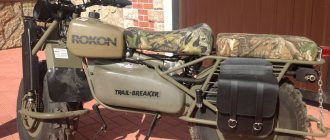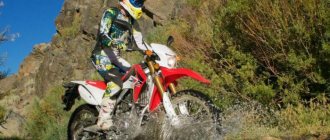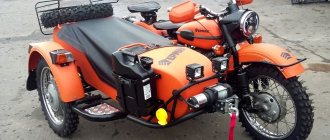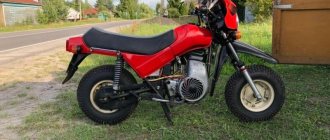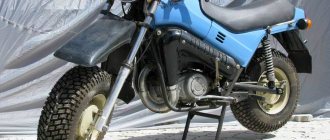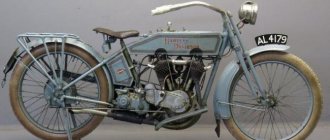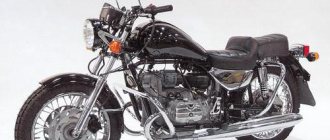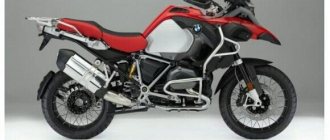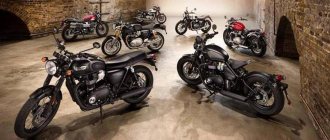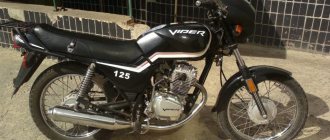How many four-wheel drive motorcycles can you name off the top of your head? Such equipment remains very highly specialized , since it is not in demand among the bulk of bikers. Of course, military developments were carried out in different countries in the past, but it was decided to abandon them everywhere. For military needs, it is not so much cross-country ability that is required as ease of repair in the field, and any motorcycle with all-wheel drive is a priori a very technically complex thing. It is possible to implement a working front-wheel drive, but does this make sense? Such an approach inevitably affects the weight of the bike and its maneuverability in a negative way, so among fans of off-road riding, regular enduro and cross bikes with a chain drive on the rear wheel are still popular.
However, this could all change. In the past, four-wheel drive vehicles were also considered unnecessary, and for the same reasons, and their popularity began to grow rapidly only after the Second World War, when rural residents appreciated the military SUVs they received at the end of hostilities. Perhaps someday 2WD motorcycles will also become in demand.
Soviet and Russian technology
Despite persistent rumors about the existence of a serial Ural with front-wheel drive, such equipment was never produced , although there were attempts by individual enthusiasts to build the corresponding custom ones on their own. with a drive to a sidecar wheel were produced (and are being produced now) . This doesn’t quite correspond to the 2x2 principle, since there are still three wheels, but the cross-country ability of these bikes is impressive. Due to their modest weight compared to a car, they can easily pass where a prepared UAZ gets stuck, and their only drawback compared to ordinary two-wheeled motorcycles is their more substantial dimensions. It is unlikely that a Ural with all-wheel drive will ever be released, but models with sidecar wheel drive are sufficient even for the most severe conditions.
Drysdale 2x2x2
Engineer Ian Drysdale from Australia became famous for his V8
and
2x2x2
.
All motorcycles are named after him and the Drysdale 2x2x2
was an earlier design, with a two-stroke engine built specifically for this motorcycle. Torque is applied to both wheels of the motorcycle using hydraulics. The rotation of both wheels (!!!) was also carried out by a hydraulic drive. According to reviews, controlling this “hydraulic-driven monster” evokes dual sensations of surprise and unusual torque.
Serial all-wheel drive motorcycles
The only company that produces such products is Rokon , and the company has been developing more and more new models since the 60s of the last century. If you wish, you can even buy them, although the meaning of such an event remains questionable - the equipment is very specific, and spare parts for it are extremely difficult to find. True, most Rokon models are completely devoid of front suspension, despite the fact that they are positioned as off-road motorcycles. The designers decided that massive low-pressure tires would be enough for shock absorption, and they began attempts to combine the front suspension on a front-wheel drive motorcycle relatively recently.
Rokon is a unique bike
Rokon engineers simply eliminated the front suspension, and low-pressure pneumatics are used as shock absorbers.
The American company Rokon, founded in 1960, can be considered the pioneer of the 2x2 formula.
Its motorcycles resemble half a tractor and are produced almost unchanged to this day - with Honda or Kohler engines, a 3-speed gearbox and a centrifugal clutch.
The front wheel is driven by a combination of chains and gears, and the engineers initially solved the problem of its movement relative to the vertical axis by simply eliminating the suspension.
This was justified by the use of low-pressure pneumatics, which ensure a smooth ride, and at the same time allow the bike not to sink in liquid mud or bury itself in sand.
Later, one of the versions still had a wishbone front suspension. To drive the front wheel, a double cardan joint is used here at the steering column, allowing the steering wheel to turn at an angle of up to 50 degrees (not every rear-wheel drive bike can boast of this), and an angular gearbox, from which the wheel is driven by two chain drives.
The Rokon is a completely unique bike that can go anywhere, and on special occasions you can carry it yourself. No wonder the Jordanian army purchased a batch of such vehicles in 2001.
Concepts and projects
Attempts to design a production all-wheel drive motorcycle have been made many times. They started decades ago, and Suzuki even showed several concepts to the public. Thus, the 2WD enduro Suzuki XF5 had a full suspension combined with front-wheel drive, implemented through a chain drive and a shaft located on the fork leg. This whole design made the bike heavier by only 8 kg, but the model, due to its exotic nature, was still not put into production. The XF5 was revealed to the public in 1991, and a second wave of interest began in the new century, amid growing interest in electric cars and electric motorcycles.
Thus, BMW even created a concept version of its famous R1200GS with a hybrid engine, and the torque at the front wheel was provided by an electric motor . The main problem in this case was the control of power on the rear wheel and on the front, since the torque is transmitted to them by two different engines. And the Austrians from KTM went even further, and in 2004 they showed a prototype of a bike with a hydraulic motor mounted on the front wheel hub. This approach helped get rid of the unnecessarily bulky front-wheel drive and generally lighten the design.
All-wheel drive operation due to chain transmission
Rotational power is transmitted to the front wheel through the chain, sprockets and CV joint in the steering unit.
This operating principle has been developed since the mid-60s, when the first mass-produced all-wheel drive off-road motorcycle, Rokon, was created in the USA.
Rokon - the founder of all-terrain vehicles
It’s hard to call it an enduro motorcycle; rather, it’s a two-wheeled all-terrain vehicle – a swamp vehicle, suitable for hunting and fishing. Large, wide tires compensate for the lack of full suspension. These four-wheel drive motorcycles are always slow-moving and, to some extent, can replace an ATV or a 4-wheeled all-terrain vehicle. They are still in demand.
If you like such a hard worker, similar equipment is produced in Russia: “Tarus”, “Argali”.
"Tarus" and "Arhar"
Prices are quite affordable, up to 200 thousand rubles. for a new all-terrain vehicle.
Here we also need to remember the all-wheel drive motorcycle of A. Garagashyan as a unique work of our compatriot.
Winner of the 1995 Russian Championship in sports motorcycle tourism
DIY custom
It is extremely difficult to install full-fledged all-wheel drive on a motorcycle with your own hands. Such custom cars exist, and there are quite a lot of them, but almost all of them are only capable of driving ten meters in a straight line at some show, and they are not suitable for real use. There are, however, exceptions, such as the famous custom “ Arhar ” from the Moscow studio “Vilar-Pro. The bike looks unprepossessing in the photo, but it is really capable of driving on almost any off-road terrain. Moreover, it was no longer produced in a single copy, since bikers appreciated the motorcycle, and orders for the next copy began to arrive regularly to the custom creators. If its next version can be equipped with suspensions that are currently missing, it will be absolutely wonderful.
Wunderlich Hybrid BMW R1200GS
As always, the BMW tuning studio Wunderlich
using
KTM's
electric hybrid. It was used on the BMW R1200GS. A new generation of batteries, generators and electric motors hints at what may be the future of motorcycles. So far, the issue of controlling the power of the front wheel and the comparison of torque with the rear wheel has not been resolved. But it seems to me that this is no longer a problem with the availability of modern software.
The best off-road motorcycle models
The vehicle, which is equipped with large diameter wheels and deep treads, can easily drive on dirt and gravel. This must be taken into account when choosing a vehicle for hunting.
The best models of motorcycles for hunting from the off-road vehicle class are presented below.
KTM 690 Enduro R (Austria). This is an all-terrain vehicle that has excellent shock absorbers, so you won’t feel any discomfort when driving over potholes and uneven dirt roads. The front wheel is slightly smaller than the rear wheel for the classic model.
Model characteristics:
- small fuel tank (12 l);
- narrow wings;
- steel frame;
- 66 l. With.;
- one cylinder that copes well with overloads, six gears;
- lightweight (140 kg);
- maneuverable;
- speed up to 167 km/h;
- high cross-country ability and power.
Among the disadvantages are the high cost of parts in case of breakdown or replacement and lack of sharpness of revolutions. The cost of the model is from 749 thousand rubles.
Lifan LF gy-5 (China). The model belongs to the budget option, therefore it is popular on the Russian market among imported vehicles. The motorcycle has all the necessary minimum for transport of this class. Maximum power – 16.3 liters. With. (for comparison, the domestically produced Java-350 motorcycle can offer 28 hp). The vehicle is not intended for long-term loads, since the engine is cooled only by air currents and can easily overheat.
Model features:
- light weight (122 kg);
- narrow tank for 10 liters of fuel (consumption 2.3 liters per 100 km);
- soft jumps on pits and potholes thanks to the pendulum rear suspension;
- speed up to 100 km/h, which is quite suitable for hunting;
- high cross-country ability and ease of maintenance.
Among the disadvantages are the relatively small tank, so you can’t go far on a motorcycle, the power is not high enough, and it is loud when riding. This option is more suitable for one person.
Kayo CRF801-7L Basic 17/14 (China). The motorcycle has four forward gears, a good hydraulic system, and the frame consists of tubular elements. The weight of the model is only 69 kg.
Motorcycle characteristics:
- lightness and maneuverability;
- ease of repair;
- direct muffler;
- power – 11 l. With.
Among the disadvantages, it is worth noting the low strength of the steering wheel, which bends when dropped, the chain stretches and there is no electric starter.
Advantages and disadvantages of the vehicle
Among the main reasons why the Ural with a leading sidecar is very popular are:
- excellent cross-country ability (the probability of getting stuck anywhere is almost zero);
- good load capacity;
- improved management;
- smoother and softer dynamics.
But the Ural all-wheel drive motorcycle also has some disadvantages. First of all, there is a more complex chassis design. In addition, there is no way to detach the stroller. At the same time, there are clearly more advantages. Especially for those who love driving on difficult roads.
Made in Italy
Cagiva Elefant 906 SP
The Italian project was focused on winning the most difficult race in the world - the Paris-Dakar rally raid. In 1990 and 1994, Eddie Oriol managed to win the race on this bike, thus realizing the idea of the ambitious Italians. As a power unit, the motorcycle used a proprietary L-shaped engine from Ducati with an equally proprietary desmodromic valve drive. The 904 cc air-cooled engine produced 78 hp. maximum power at 8000 rpm, and its gas distribution mechanism had only two valves per cylinder. Experts from a well-known motorcycle grandee in the person of Ducati took part in the development of the motorcycle.
Bobby Haas and his Haas Moto Museum
Today, something similar is happening in the world of motorcycle customization. One of the luminaries is Bobby Haas and his Haas Moto Museum in Dallas.
Bobby has managed to amass a collection of more than 130 unusual motorcycles, and sometimes he gives them away for conversion. Khazan is one of his protégés, Craig Rodsmith is another. It was his incredible front-wheel drive motorcycle that recently became a permanent resident of the hallowed halls.
This is a classic story of patron and artist working in tandem. It started last year when Bobby suffered from a bout of insomnia during the Handbuilt Show, which is held annually in Austin, Texas.
Bobby Haas says:
After a sleepless night, I went online. And I came across vintage photographs of an Art Deco motorcycle created by a group of German engineers in the 1930s.
It was a Killinger und Freund motorcycle, built in Munich between the two world wars.
I bought a motorcycle to ride, not to fall
This article is not quite in Habr format, but, observing the pace at which the number of two-wheelers on the streets of the capital is growing, including among IT workers, I will still take a risk - maybe it will save several lives, which is not so bad.
When I bought my first motorcycle 10 years ago, any encounter with two-wheelers on the road was an event.
Over the past few years, the situation has changed dramatically - traffic jams from motorcycles in the aisles are already an everyday occurrence. I won’t think about why this is happening, but will try to simply share my experience of “surviving in a big city” with those who have just bought it or are just thinking about it. It is quite possible that some things will be useful to fans of electric vehicles. A little bit about yourself.
Or why, as it seems to me, you can listen to my words. Katya has been around for about 10 years now. I drove a lot of things. Plus or minus 18K in Moscow per year in any weather, except for snowfall and very cold weather (at -15 it’s already difficult to start). I participated as a volunteer first in Motocitizen, then in MotoMoscow Road Accident. In the first I worked on statistics (some numbers will be from there, but from memory), for the second I wrote and am somehow trying to support a mobile application for alerting about accidents. I have been in and under a car many times, but much more often I have observed others in similar situations.
Choosing a motorcycle school
It would seem, what does school have to do with it?
In fact, very much so. To obtain a category A license in Russia, you just need to pass the traffic rules theory and skate the area. In theory, everything is clear, but practice, in the vast majority of motorcycle schools, consists solely of training to pass the site, and in the most effective way. Everything would be fine, but the trouble is that the maneuvering and landing skills most suitable for passing it are not only useless in the city - they are harmful. All this leads to the fact that first-season students who have just received their license are retrained on their own, according to the “Brazilian system,” well, if without any loss in health. So for those who have not yet chosen a school, I strongly recommend that your primary attention should not be paid to the cost and promises to “pass the first time,” but to the availability of a driving training program in the city and to reviews in thematic public pages/forums.
How to avoid getting into an accident
No way.
I don’t know a single motorcyclist who has ridden for at least 3-4 seasons and who hasn’t been in an accident at least once. No, perhaps there are such people, but I don’t know them. So the phrase from the headline, which at one time became a local meme, has little to do with reality. Just when you get on a motorcycle, keep in mind that you may very well not get there.
How to reduce the likelihood of getting into an accident
This topic cannot be covered in one article - entire books are devoted to it. I will limit myself to a few tips on the most common mistakes of first-season players. Not the standard “don’t speed”, “don’t drink and drive”, etc., but, let’s say, unwritten rules.
- Practice emergency braking. Just in the evening, go to an empty area and accelerate-braking-acceleration-braking-acceleration-... You should feel the moment of the rear wheel breaking off with your butt (this is not a figure of speech). The right hand and right leg should be able to independently brake effectively, at the level of reflexes. You have not yet realized the tragedy of the situation, but the rear one is already pinned down, and a moment later the front one starts moving.
Lyrical digression:“To avoid a collision, I put the motorcycle down” - remember this phrase and never use it in conversation with understanding people. When talking to girls, it’s okay - it’s a sin not to post heroic noodles. In the most efficient and controllable(!) way, the motorcycle brakes with its wheels. A motorcycle that has fallen on its side is a bullet with a displaced center of gravity, which is almost not affected by friction. Those. flies far, quickly and along an unpredictable trajectory, often intersecting with a pilot flying along the same trajectory. And it’s plus or minus two hundred kilos for a minute.
- Don't drive to the right of the right. There you will find open car doors, turns into the yard and “oh, they called me and I decided to park!” The right side of the right lane is the last place a motorist expects to meet someone. And the dead zone there is quite large.
A little harshness (hereinafter from personal volunteer experience)A Kamaz passenger opened the door in a standing traffic jam. The motorcyclist has minus three fingers.
- Don't drive to the left of the left. There are people turning left and turning around waiting for you. Often through a double solid line and quickly. After all, “Who’s going to overtake me in the oncoming lane (the left side of the left lane)!?” Turning a car left/U-turn is one of the most common and bloodiest types of accidents involving motorcycles. By the way, the photo above is from last Friday, when a patrol car turning left didn’t notice me.
A little toughAt random I discovered five from the “We Remember” project - this is a project about those who have gone to the land of the eternal season. Three out of five.
- The motorcycle was moving to the left of the general flow, a Volkswagen car, moving in the same direction, began to turn in violation of the requirements of the road sign, which only allows driving straight or to the right.
- The driver of a VAZ-2109 car did not give way to a motorcycle when turning. The motorcyclist overturned his motorcycle while braking and ended up between the car and the motorcycle during the collision.
The driver of a Mazda 3 did not let the motorcycle pass when turning left. The driver and passenger of the motorcycle died at the scene of the accident.
A little tough
The lower half of the body is on the first bump stop. The top one is on the second. Between them is tripe. The guy slipped in the turn between Ryazanka and Volgogradka. A very unappetizing sight.
A little tough
The left leg was ground into dust on the jeep, the right hand on the gazelle.
A little tough
It won't happen here. I’ve never gone to one of these - God has had mercy. But a couple of times I personally covered the road with bricks when another careless rider flew into the aisle, right in front of me.
A little tough
The BMW X6 was in a hurry and jumped from lane to lane. Two children did not receive a folder from work.
A little tough
A drunken teenager running across the road was neatly folded into a black bag, and the motorcyclist was taken to intensive care. If he is very lucky, then after recovery he will face long legal ordeals with unpredictable results.
How to increase the likelihood of staying alive after an accident (preferably in one piece)
To paraphrase Ballmer - “Gear!
Equipment! Equipment! Equipment!" According to traffic regulations, a motorcyclist is required to wear a helmet. Unfortunately, many people limit themselves to this. At the most, buy a cool jacket and fashionable gloves. The first season is ordinary: helmet, jacket, gloves... jeans and sneakers. Heartless bastard statistics tell us that the majority of all serious injuries occur on the legs (according to the rather leaky Motocitizen statistics - about 45%). And all because in most cases they are the ones who take the first blow. Well, the landing is because this is the difference in height between a motorcycle and a car. After the first blow, you often still have to slide on a rasp called asphalt.
Moreover, you have to slide with the soft parts of the same legs. There is even such a term - asphalt disease, this is when half of the ass is smeared in a thin layer on the road, and the second contains patches of melted trousers. And yes, the only thing a Chinese helmet that costs a thousand rubles can save you from is a fine for not having one.
A little tough
My first two trips as a volunteer occurred during traumatic foot amputations... In sneakers.
And I personally experienced asphalt sickness - it’s very unpleasant, I must say. By the way, your spine will also be very happy if the blow falls not on it, but on a special protective “back”.
Yes, equipment is quite expensive. A complete and good kit may cost half the price of a motorcycle, but it's really worth it.
Important note - all of the above also applies to your passenger. Even the most beautiful girl becomes a very ugly piece of meat if she rides with you in a miniskirt over her bare head. Believe me, I saw it.
What to do if you are in an accident and survive
The peculiarity of accidents involving a motorcycle is that immediately after the accident and for half an hour after, the pilot contains a huge dose of adrenaline. There have been cases when a person jumped up on broken legs and rushed to lift a motorcycle using only his muscles, without a frame. And after 10 minutes it turned green and turned off.
- The first and most important rule is to make sure you are okay. If there is the slightest suspicion, strange pain, unclear perception of the world - lie down in a safe place and wait for an ambulance. There was a case (I was not personally present) - the pilot bruised his stomach, it didn’t seem to hurt, he refused the ambulance, no matter how much they asked him, and in the evening, already from home, he left in a sad car. The sad car is the same as the cheerful one, also with a red stripe, but without a flashing light. Because there is no need to rush anymore.
- A very common misconception, typical not only of first-season drivers, is “I was driving in the middle of the road, so that means it’s my fault.” No and no again. In 70% of cases of motorcycle/auto accidents (statistics from volunteer trips), if there is a knowledgeable person with a cool head on the spot (and not a pilot whose adrenaline is going through the roof), the car is found guilty. There is no need to immediately take the blame upon yourself. With this you will please the traffic cop, you will greatly please Mamzel, who did not look in the mirror when changing lanes, and you will greatly upset your insurance company, and then, upon realization, yourself. Call your friends, or better yet, “MotoMoscow/MotoRussia Road Accident”, for example, and wait for the volunteers who ate the dog on this matter.
- Don't lift your motorcycle without a very good reason. The traffic police officer will document and describe the accident based on the facts of what he sees. And exactly those photos that he takes will be used. A raised motorcycle is an opportunity for the second participant to distort the facts, and for investigators this is generally tantamount to the destruction of evidence.
Well, a few words about the rules of good manners and some misconceptions
- If they catch up with you in the aisle, let them pass. If you drive on principle without noticing anyone, then at best you will be considered an idiot, and at worst, after 15 minutes of nausea, the liter sport will begin to overtake you in the next aisle. I wrote above what this leads to.
- If you see an accident with a two-wheeler, slow down and ask if they need help. Remember that he is most likely feeling very bad right now and has little understanding of what is going on.
- If you saw an accident with a two-wheeler where someone had already stopped and showed you with his hand “drive on” - drive on. With a high degree of probability, this is a visiting volunteer whom the traffic police officers do not drive away as long as he helps them not to create a crowd of loitering motorcyclists on the spot.
- For lovers of non-stock forward flow and long-range xenon at night, a separate boiler in hell has been prepared.
- In the traffic rules there is no such thing as “row spacing” - there is driving in a row and changing lanes while crossing the markings. According to traffic rules, two vehicles can be parked parallel in the same row if a safe lateral interval is maintained. The safe lateral interval is not regulated in any way.
- Well, the most important thing. Remember that no one owes you anything. Before demanding respect from motorists, first learn to respect their right not to let you pass.
That's all. Don't fly faster than your guardian angel.
useful links
Testing of helmets: Safety Helmet Assessment & Rating Program Volunteer organization for assistance in case of accidents with motor vehicles: MotoMoscow/MotoRussia Road accidents Another volunteer organization: Motocitizen Project “Remember” Lee Parks “Full Control” UPD from comments: Helmet, debriefing David Hough, “Road strategy"
Christini.
A truly all-wheel drive motorcycle, this is a model from the American company Christini.
They have been converting motorcycles to all-wheel drive for many years, and also produce kits for such modifications.
The system is similar to the Suzuki XF5 with a chain drive from the drive sprocket to a telescopic shaft running along the front of the motorcycle, transmitting torque to the motorcycle wheel hub through a gearbox. It sounds complicated, but the system is quite lightweight and fits a variety of makes and models of motorcycles. Christini
makes several models of pre-converted bikes and sells RIT kits, including modified frames.
Christini,
specializing in off-road motorcycles, also made a road racer in
2008
to prove that all-wheel drive could help racers on asphalt.
Pitbike
A pitbike is a small cross-country motorcycle. As a rule, they have small wheels 17/14, 14/12 inches or smaller. Engines with a horizontal cylinder, volume from 50 to 190 cubic meters. The first pit bikes appeared in the vicinity of racing tracks and were used to move personnel around the subdock. They were two-wheeled vehicles, often without suspension. Often such minibikes were used for entertainment and fun. By the 90s, pit bikes had acquired a modern and familiar image. Nowadays, this type of equipment still serves for fun rides, both for adults and for children and teenagers.
Myths about street motorcycles
We would like to dispel the following common misconceptions:
- Driving is dangerous - if you follow traffic rules and adhere to recommended speed limits, you will get into accidents no more often than in a car.
- Frivolous transport - only those who perceive a bike as a means of entertainment think so, whereas this is a whole philosophy.
- The more protection, the lower the risk of injury - optional elements hinder movement, interfering with control, and therefore can provoke an accident.
- An expensive pleasure - you can give preference to budget transport for a beginner, the cost of which will be several times lower than the price of the car.
Made in Austria
KTM 660/690 LC4 Adventure
In 1999, the Austrians created a motorcycle that, with some changes, managed to become a five-time champion in the Dakar rally-raid. The bike was equipped with a 654 cc single-cylinder four-valve engine, the maximum power of which was 52 hp. at 7000 rpm. The inverted fork with a 50 mm stanchion diameter had a travel of 270 mm, and a rear travel of 310 mm. The dry weight of the motorcycle was 170 kg, the fuel capacity was 55 liters.
KTM 450 Rally
The KTM 450 Rally was developed in response to changes in rally raid regulations. In 2010, a motorcycle with a massive chrome-molybdenum frame was presented to the public. The motorcycle is powered by a single-cylinder 450 cc engine. Suspension: Upside-down fork at the front and adjustable WP shock absorber at the rear. The dry weight of the bike is a little less than one and a half centners.
Which brand of motorcycle should I choose?
Traditionally, the Russian market is represented mainly by Asian companies, whose vehicles are very popular. The leaders are Japanese companies (Kawasaki, Suzuki, Yamaha, Honda) and Chinese (Viper). But if Japanese motorcycles are already considered classics, since they have been on the market for more than 100 years, then Chinese models have recently become more competitive with them.
A review of Chinese motorcycles will be presented below. Vehicles from the Middle Kingdom are chosen for the following reasons:
Such classic and well-known models of domestic production as “Ural”, “Izh” and “Java” are no less popular among Russian consumers. They can be easily purchased secondhand and in terms of price they outperform all foreign models, but we will consider below whether their quality meets the required parameters.
Recommendations for choosing a touring motorcycle for travel
Be sure to consider the following points:
The nature of the road surface - if it is assumed that the iron horse will roll only on asphalt roads, you don’t have to worry too much. If you plan to conquer rough terrain, you need the bike to have a rigid suspension and other off-road attributes. Curb weight - don’t be afraid of a weight of 200 or even 500 kg, for this family this is the norm. But you should remember one simple rule: the lighter the vehicle, the more maneuverable it is, and it’s easier to control when taking turns. On the other hand, the heavier it is, the more stable and safer it is at speed. Duration of the trip - a modern long-distance motorcycle should have a spacious luggage compartment, because you will almost certainly have to take a lot of things with you, especially if you are traveling with someone. One trunk is suitable for outings to the country or on a picnic, but for throws of 300-500 km there should be three of them, with a volume of 90-100 liters. By the way, compatibility with a trailer, two- or single-axle, in this case will be an additional advantage. Fuel tank capacity - manufacturers vary it in the range from 10 to 30 liters. The larger the tank, the longer you can drive without refueling, but also the heavier your vehicle, which means you should exercise moderation. For short distances, 15 liters is enough; for long distances, 25 liters is enough. Presence/absence of a passenger - the best motorcycle for traveling for two simply must have a roomy seat, even if this increases its weight. Therefore, the optimal choice in this case is cruisers rather than enduro and sports. By the way, conquering hundreds of kilometers in pairs with someone is not only more fun (or more romantic), but also safer. Comfort – driving for several hours in a row can be very tiring, so it’s good if the model you like is equipped with solutions to increase comfort and reduce the level of fatigue. We’ll also add technology here: adjustable wind protection and heated grips, LED optics and USB connectors on the dashboard will be definite advantages. But remember, long-distance motorcycles cost more the more additional features they have. Maintainability - today it is better to give preference to those models that are equipped with electronic diagnostic systems that promptly notify of the occurrence of a malfunction
Although it is important not only how often the bike breaks down, but also how easy it is to get spare parts for it, whether there are service centers of its manufacturer in your city or region.
We have given you the main guidelines, now we move on to a substantive examination of specific families, series and collections so that you can get to know the market leaders better.
Test evaluation of Yamaha XTZ Super Tenere
Dynamics - At the level of enduro racing
Handling - If not for the thin fork!
Comfort - A true all-terrain vehicle
Brakes - Dangerous for an untrained pilot
Ergonomics - as it is
Drive - Match the motorcycle's capabilities
+ excellent performance of a forced engine at any speed
+ good balance of on-road and off-road properties - predictable behavior in all conditions
+ comfortable driving position
- noisy engine requires attention
— excessively powerful front brake is prone to wheel locking
— soft front fork removes the driver from control
= virtually unlimited possibilities in the hands of a skilled pilot.
End?
Africa immediately, from the first seconds, envelops you with an aura of comfort and security. The motorcycle seems to tell you: show me the way, and I’ll do the rest myself. There is no need to fight with him, it is enough to establish a connection with him at the soul level - unity is guaranteed. And then go out onto the highway and drive several hundred kilometers, just for fun. But the comfort of Africa is not the comfort of a luxury tourer; not a single tourer is suitable for Russian roads. And Africa is adapted. And at the same time, it is absolutely reliable, in this very few people can compare with it. There are very few such completed, successful motorcycles.
It's a pity that production was discontinued in 2003.. but now Honda presents us with a new Africa!
So what do we know about the new Africa?
Engine: 70 kW (94 hp) at 7500 rpm and 98 Nm at 6000 rpm. The weight of the base model without fuel is from 225 kg, with ABS – up to 232 kg, with DCT – up to 242 kg.
The front fork diameter is 45 mm, and the suspension travel of all three models is 230 mm at the front and 220 mm at the rear - better than the KTM 1190 (which replaced the 990), which is considered the main competitor of the CRF1000L Africa Twin.
Many people will probably be a little upset by these specifications. As you already understood, the Japanese manufacturer focused on travelers and off-roading, so the new Africa is significantly inferior in power to the BMW R1200GS Adventure (125 hp) and KTM 1190 Adventure R (147 hp). Weight is also a contentious issue, especially the extra pounds with the optional DCT option. Although, it should be noted the ability of Honda engineers to make their motorcycles in such a way that the weight of the car seems less than it actually is. The Honda representative office in Europe also announced the cost of the base model - 12,999 €, which is also more expensive than many had hoped.
The history of the GS series from BMW is no less interesting. Back in 1981 (a year before the Africa Twin appeared), the Bavarians were poring over the idea of a touring enduro. While the Japanese sat and conjured over the drawings, the Germans were preparing to use Dakar to present the model in all its glory. The collaboration with the enduro-specializing HPN brought the racing version as many as 2 victories - first place in the more racing version and seventh in the almost production R80G/S
The same driver repeated his success in 1983, also winning the famous American Baja 1000 race. Obviously, the production version of the BMW R80G/S Paris-Dakar soon saw the light, and by the mid-80s, sales of the BMW G/S accounted for approximately a fifth of the total sales of Bavarian motorcycles. However, the issue of making a profit still haunted me and a solution was found quickly.
